Spatiotemporal Analysis of Future Trends in Terrestrial Water Storage Anomalies at Different Climatic Zones of India Using GRACE/GRACE-FO
Abstract
1. Introduction
2. Study Area and Data Resources
2.1. Study Area
2.2. Data Source: GRACE-Derived TWSAs
3. Modeling Results
3.1. Seasonal Homogeneity Test Results
3.1.1. Winter Season
3.1.2. Pre-Monsoon Season
3.1.3. Monsoon Season
3.1.4. Post-Monsoon Season
3.1.5. Annual Mean
3.2. Trend Analysis
3.2.1. Winter Season
3.2.2. Pre-Monsoon Season
3.2.3. Monsoon Season
3.2.4. Post-Monsoon Season
3.2.5. Annual Mean
4. Discussion
5. Methods
5.1. Homogeneity Test
5.1.1. Pettitt’s Test (PT)
5.1.2. Buishand Range Test (BRT)
5.1.3. The Standard Normal Homogeneity Test (SNHT)
5.1.4. Von Neumann Ratio Test (VNRT)
5.2. Trend Analysis
5.2.1. Autocorrelation
Mann–Kendall Trend Test (MK)
Modified Mann–Kendall Test (MMK)
Sen’s Slope Estimator
5.2.2. Linear Regression Analysis
6. Conclusions
Author Contributions
Funding
Institutional Review Board Statement
Informed Consent Statement
Data Availability Statement
Conflicts of Interest
References
- Meng, F.; Su, F.; Li, Y.; Tong, K. Changes in Terrestrial Water Storage during 2003–2014 and Possible Causes in Tibetan Plateau. J. Geophys. Res. Atmos. 2019, 124, 2909–2931. [Google Scholar] [CrossRef]
- Famiglietti, J.S. Remote sensing of terrestrial water storage, soil moisture and surface waters. Geophys. Monogr. Ser. 2004, 150, 197–207. [Google Scholar]
- Huang, Y.; Salama, M.S.; Krol, M.S.; Van Der Velde, R.; Hoekstra, A.Y.; Zhou, Y.; Su, Z. Analysis of long-term terrestrial water storage variations in the Yangtze River basin. Hydrol. Earth Syst. Sci. 2013, 17, 1985–2000. [Google Scholar] [CrossRef]
- Güntner, A. Improvement of global hydrological models using GRACE data. Surv. Geophys. 2008, 29, 375–397. [Google Scholar] [CrossRef]
- Zhang, Y.; He, B.; Guo, L.; Liu, J.; Xie, X. The relative contributions of precipitation, evapotranspiration, and runoff to terrestrial water storage changes across 168 river basins. J. Hydrol. 2019, 579, 124194. [Google Scholar] [CrossRef]
- Zhang, Y.; He, B.I.N.; Guo, L.; Liu, D. Differences in response of terrestrial water storage components to precipitation over 168 global river basins. J. Hydrometeorol. 2019, 20, 1981–1999. [Google Scholar] [CrossRef]
- Zhu, Y.; Liu, S.; Yi, Y.; Xie, F.; Grünwald, R.; Miao, W.; Wu, K.; Qi, M.; Gao, Y.; Singh, D. Overview of terrestrial water storage changes over the Indus River Basin based on GRACE/GRACE-FO solutions. Sci. Total Environ. 2021, 799, 149366. [Google Scholar] [CrossRef]
- Döll, P.; Douville, H.; Güntner, A.; Müller Schmied, H.; Wada, Y. Modelling Freshwater Resources at the Global Scale: Challenges and Prospects. Surv. Geophys. 2016, 37, 195–221. [Google Scholar] [CrossRef]
- Li, X.; Cheng, G.; Ge, Y.; Li, H.; Han, F.; Hu, X.; Tian, W.; Tian, Y.; Pan, X.; Nian, Y.; et al. Hydrological Cycle in the Heihe River Basin and Its Implication for Water Resource Management in Endorheic Basins. J. Geophys. Res. Atmos. 2018, 123, 890–914. [Google Scholar] [CrossRef]
- Frappart, F.; Ramillien, G. Monitoring groundwater storage changes using the Gravity Recovery and Climate Experiment (GRACE) satellite mission: A review. Remote Sens. 2018, 10, 829. [Google Scholar] [CrossRef]
- Hosseini-Moghari, S.M.; Araghinejad, S.; Ebrahimi, K.; Tang, Q.; AghaKouchak, A. Using GRACE satellite observations for separating meteorological variability from anthropogenic impacts on water availability. Sci. Rep. 2020, 10, 15908. [Google Scholar] [CrossRef]
- Iqbal, N.; Evans, T.A.; Saeed, S.; Khan, H.A.A. Evaluation of fipronil baits against Microtermes mycophagus (Blattodea: Termitidae). Can. Entomol. 2016, 148, 343–352. [Google Scholar] [CrossRef]
- Mays, L.W. Groundwater Resources Sustainability: Past, Present, and Future. Water Resour. Manag. 2013, 27, 4409–4424. [Google Scholar] [CrossRef]
- Rodell, M.; Velicogna, I.; Famiglietti, J.S. Satellite-based estimates of groundwater depletion in India. Nature 2009, 460, 999–1002. [Google Scholar] [CrossRef]
- Garduño, H.; Romani, S.; Sengupta, B.; Tuinhof, A.; Davis, R. India Groundwater Governance, A Case Study; Water Partnersh. Program; World Bank: Washington, DC, USA, 2011. [Google Scholar]
- Sekhri, S. Sustaining groundwater: Role of policy reforms in promoting conservation in India. Shekhar Shah Barry Bosworth Arvind Panagariya 2013, 149, 149–187. [Google Scholar]
- Mukherjee, A.; Ramachandran, P. Prediction of GWL with the help of GRACE TWS for unevenly spaced time series data in India: Analysis of comparative performances of SVR, ANN and LRM. J. Hydrol. 2018, 558, 647–658. [Google Scholar] [CrossRef]
- Balachandran, A.; Scientist, D. Central Ground Water Board; Ministry of Water Resources (Government of India): Chennai, India, 2009. [Google Scholar]
- Pettitt A Non-parametric to the Approach Problem. Appl. Stat. 1979, 28, 126–135. [CrossRef]
- Alexandersson, H. A homogeneity test applied to precipitation data. J. Climatol. 1986, 6, 661–675. [Google Scholar] [CrossRef]
- Buishand, T.A. Some methods for testing the homogeneity of rainfall records. J. Hydrol. 1982, 58, 11–27. [Google Scholar] [CrossRef]
- Von Neumann, J. Distribution of the Ratio of the Mean Square Successive Difference to the Variance. Ann. Math. Stat. 1941, 33, 1187–1192. [Google Scholar] [CrossRef]
- Borah, P.; Hazarika, S.; Prakash, A. Assessing the State of Homogeneity, Variability and Trends in the Rainfall Time Series from 1969 to 2017 and Its Significance for Groundwater in North-East India; Springer: Enschede, The Netherlands, 2021; ISBN 0123456789. [Google Scholar]
- Wijngaard, J.B.; Klein Tank, A.M.G.; Können, G.P. Homogeneity of 20th century European daily temperature and precipitation series. Int. J. Climatol. 2003, 23, 679–692. [Google Scholar] [CrossRef]
- Hänsel, S.; Medeiros, D.M.; Matschullat, J.; Petta, R.A.; de Mendonça Silva, I. Assessing homogeneity and climate variability of temperature and precipitation series in the capitals of North-Eastern Brazil. Front. Earth Sci. 2016, 4, 1–21. [Google Scholar] [CrossRef]
- Tabari, H.; Somee, B.S.; Zadeh, M.R. Testing for long-term trends in climatic variables in Iran. Atmos. Res. 2011, 100, 132–140. [Google Scholar] [CrossRef]
- Wang, Y.; Xu, Y.; Lei, C.; Li, G.; Han, L.; Song, S.; Yang, L.; Deng, X. Spatio-temporal characteristics of precipitation and dryness/wetness in Yangtze River Delta, eastern China, during 1960–2012. Atmos. Res. 2016, 172–173, 196–205. [Google Scholar] [CrossRef]
- Bari, S.H.; Rahman, M.T.U.; Hoque, M.A.; Hussain, M.M. Analysis of seasonal and annual rainfall trends in the northern region of Bangladesh. Atmos. Res. 2016, 176–177, 148–158. [Google Scholar] [CrossRef]
- Bisht, D.S.; Chatterjee, C.; Raghuwanshi, N.S.; Sridhar, V. Spatio-temporal trends of rainfall across Indian river basins. Theor. Appl. Climatol. 2018, 132, 419–436. [Google Scholar] [CrossRef]
- Singh, R.; Sah, S.; Das, B.; Vishnoi, L.; Pathak, H. Spatio-temporal trends and variability of rainfall in Maharashtra, India: Analysis of 118 years. Theor. Appl. Climatol. 2021, 143, 883–900. [Google Scholar] [CrossRef]
- Javari, M. Trend and homogeneity analysis of precipitation in Iran. Climate 2016, 4, 9–13. [Google Scholar] [CrossRef]
- Watkins, M.M.; Wiese, D.N.; Yuan, D.N.; Boening, C.; Landerer, F.W. Improved methods for observing Earth’s time variable mass distribution with GRACE using spherical cap mascons. J. Geophys. Res. Solid Earth 2015, 120, 2648–2671. [Google Scholar] [CrossRef]
- Hasan, E.; Tarhule, A. Comparison of decadal water storage trends from common GRACE releases (RL05, RL06) using spatial diagnostics and a modified triple collocation approach. J. Hydrol. X 2021, 13, 100108. [Google Scholar] [CrossRef]
- Wang, X.-J.; Zhang, J.-Y.; Shahid, S.; Guan, E.-H.; Wu, Y.; Gao, J.; He, R.-M. Adaptation to climate change impacts on water demand. Mitig. Adapt. Strateg. Glob. Chang. 2016, 21, 81–99. [Google Scholar] [CrossRef]
- Food and Agriculture Organization. World Food and Agriculture; Food and Agriculture Organization United Nations: Rome, Italy, 2013; Volume 15. [Google Scholar]
- Malik, A.; Kumar, A.; Kim, S.; Kashani, M.H.; Karimi, V.; Sharafati, A.; Ghorbani, M.A.; Al-Ansari, N.; Salih, S.Q.; Yaseen, Z.M. Modeling monthly pan evaporation process over the Indian central Himalayas: Application of multiple learning artificial intelligence model. Eng. Appl. Comput. Fluid Mech. 2020, 14, 323–338. [Google Scholar] [CrossRef]
- Bhanja, S.N.; Mukherjee, A.; Saha, D.; Velicogna, I.; Famiglietti, J.S. Validation of GRACE based groundwater storage anomaly using in-situ groundwater level measurements in India. J. Hydrol. 2016, 543, 729–738. [Google Scholar] [CrossRef]
- Chatterjee, R.; Gupta, B.K.; Mohiddin, S.K.; Singh, P.N.; Shekhar, S.; Purohit, R. Dynamic groundwater resources of National Capital Territory, Delhi: Assessment, development and management options. Environ. Earth Sci. 2009, 59, 669–686. [Google Scholar] [CrossRef]
- Hsu, Y.J.; Fu, Y.; Bürgmann, R.; Hsu, S.Y.; Lin, C.C.; Tang, C.H.; Wu, Y.M. Assessing seasonal and interannual water storage variations in Taiwan using geodetic and hydrological data. Earth Planet. Sci. Lett. 2020, 550, 116532. [Google Scholar] [CrossRef]
- He, Q.; Chun, K.P.; Sum Fok, H.; Chen, Q.; Dieppois, B.; Massei, N. Water storage redistribution over East China, between 2003 and 2015, driven by intra- and inter-annual climate variability. J. Hydrol. 2020, 583, 124475. [Google Scholar] [CrossRef]
- Hasan, M.S.U.; Rai, A.K. Groundwater quality assessment in the Lower Ganga Basin using entropy information theory and GIS. J. Clean. Prod. 2020, 274, 123077. [Google Scholar] [CrossRef]
- Landerer, F.W.; Swenson, S.C. Accuracy of scaled GRACE terrestrial water storage estimates. Water Resour. Res. 2012, 48. [Google Scholar] [CrossRef]
- Hamed, K.H.; Ramachandra Rao, A. A modified Mann-Kendall trend test for autocorrelated data. J. Hydrol. 1998, 204, 182–196. [Google Scholar] [CrossRef]
- Peel, M.C.; Finlayson, B.L.; McMahon, T.A. Updated world map of the Köppen-Geiger climate classification. Hydrol. Earth Syst. Sci. 2007, 11, 1633–1644. [Google Scholar] [CrossRef]
- Armanuos, A.M.; Al-Ansari, N.; Yaseen, Z.M. Cross assessment of twenty-one different methods for missing precipitation data estimation. Atmosphere 2020, 11, 389. [Google Scholar] [CrossRef]
- Reeves, J.; Chen, J.; Wang, X.L.; Lund, R.; Lu, Q.Q. A review and comparison of changepoint detection techniques for climate data. J. Appl. Meteorol. Climatol. 2007, 46, 900–915. [Google Scholar] [CrossRef]
- Verstraeten, G.; Poesen, J.; Demarée, G.; Salles, C. Long-term (105 years) variability in rain erosivity as derived from 10-min rainfall depth data for Ukkel (Brussels, Belgium): Implications for assessing soil erosion rates. J. Geophys. Res. Atmos. 2006, 111, 1–11. [Google Scholar] [CrossRef]
- Martínez, M.D.; Serra, C.; Burgueño, A.; Lana, X. Time trends of daily maximum and minimum temperatures in Catalonia (ne Spain) for the period 1975–2004. Int. J. Climatol. 2010, 30, 267–290. [Google Scholar] [CrossRef]
- Daba, M.H.; Ayele, G.T.; You, S. Long-term homogeneity and trends of hydroclimatic variables in upper awash river basin, Ethiopia. Adv. Meteorol. 2020, 2020, 8861959. [Google Scholar] [CrossRef]
- Bingham, C.; Nelson, L.S.; Bingham, C.; Nelson, L.S. An Approximation for the Distribution of the von Neumann Ratio Linked references are available on JSTOR for this article: An Approximation for the Distribution of the von Neumann Ratio. Technometrics 2016, 23, 285–288. [Google Scholar] [CrossRef]
- Salman, S.A.; Shahid, S.; Afan, H.A.; Shiru, M.S.; Al-Ansari, N.; Yaseen, Z.M. Changes in Climatic Water Availability and Crop Water Demand for Iraq Region. Sustainability 2020, 12, 3437. [Google Scholar] [CrossRef]
- Salman, S.A.; Shahid, S.; Sharafati, A.; Ahmed Salem, G.S.; Abu Bakar, A.; Farooque, A.A.; Chung, E.-S.; Ahmed, Y.A.; Mikhail, B.; Yaseen, Z.M. Projection of Agricultural Water Stress for Climate Change Scenarios: A Regional Case Study of Iraq. Agriculture 2021, 11, 1288. [Google Scholar] [CrossRef]
- Mann, H.B. Non-Parametric Test Against Trend. Econometrica 1945, 13, 245–259. [Google Scholar] [CrossRef]
- Daneshvar Vousoughi, F.; Dinpashoh, Y.; Aalami, M.T.; Jhajharia, D. Trend analysis of groundwater using non-parametric methods (case study: Ardabil plain). Stoch. Environ. Res. Risk Assess. 2013, 27, 547–559. [Google Scholar] [CrossRef]
- Jhajharia, D.; Dinpashoh, Y.; Kahya, E.; Choudhary, R.R.; Singh, V.P. Trends in temperature over Godavari River basin in Southern Peninsular India. Int. J. Climatol. 2014, 34, 1369–1384. [Google Scholar] [CrossRef]
- Dinpashoh, Y.; Mirabbasi, R.; Jhajharia, D.; Abianeh, H.Z.; Mostafaeipour, A. Effect of Short-Term and Long-Term Persistence on Identification of Temporal Trends. J. Hydrol. Eng. 2014, 19, 617–625. [Google Scholar] [CrossRef]
- Zamani, R.; Mirabbasi, R.; Abdollahi, S.; Jhajharia, D. Streamflow trend analysis by considering autocorrelation structure, long-term persistence, and Hurst coefficient in a semi-arid region of Iran. Theor. Appl. Climatol. 2017, 129, 33–45. [Google Scholar] [CrossRef]
- Praveen, B.; Talukdar, S.; Shahfahad; Mahato, S.; Mondal, J.; Sharma, P.; Islam, A.R.M.T.; Rahman, A. Analyzing trend and forecasting of rainfall changes in India using non-parametrical and machine learning approaches. Sci. Rep. 2020, 10, 10342. [Google Scholar] [CrossRef]
- Yue, S.; Wang, C. The Mann-Kendall Test Modified by Effective Sample Size to Detect Trend in Serially Correlated Hydrological Series. Water Resour. Manag. 2004, 18, 201–218. [Google Scholar] [CrossRef]
- Sen, P.K. Estimates of the Regression Coefficient Based on Kendall’s Tau. J. Am. Stat. Assoc. 1968, 63, 1379–1389. [Google Scholar] [CrossRef]
- Islam, A.T.; Shen, S.; Yang, S.; Hu, Z.; Chu, R. Assessing recent impacts of climate change on design water requirement of Boro rice season in Bangladesh. Theor. Appl. Climatol. 2019, 138, 97–113. [Google Scholar] [CrossRef]
- Zinat, M.R.M.; Salam, R.; Badhan, M.A.; Islam, A.R.M.T. Appraising drought hazard during Boro rice growing period in western Bangladesh. Int. J. Biometeorol. 2020, 64, 1687–1697. [Google Scholar] [CrossRef]
- Meshram, S.G.; Singh, V.P.; Meshram, C. Long-term trend and variability of precipitation in Chhattisgarh State, India. Theor. Appl. Climatol. 2017, 129, 729–744. [Google Scholar] [CrossRef]
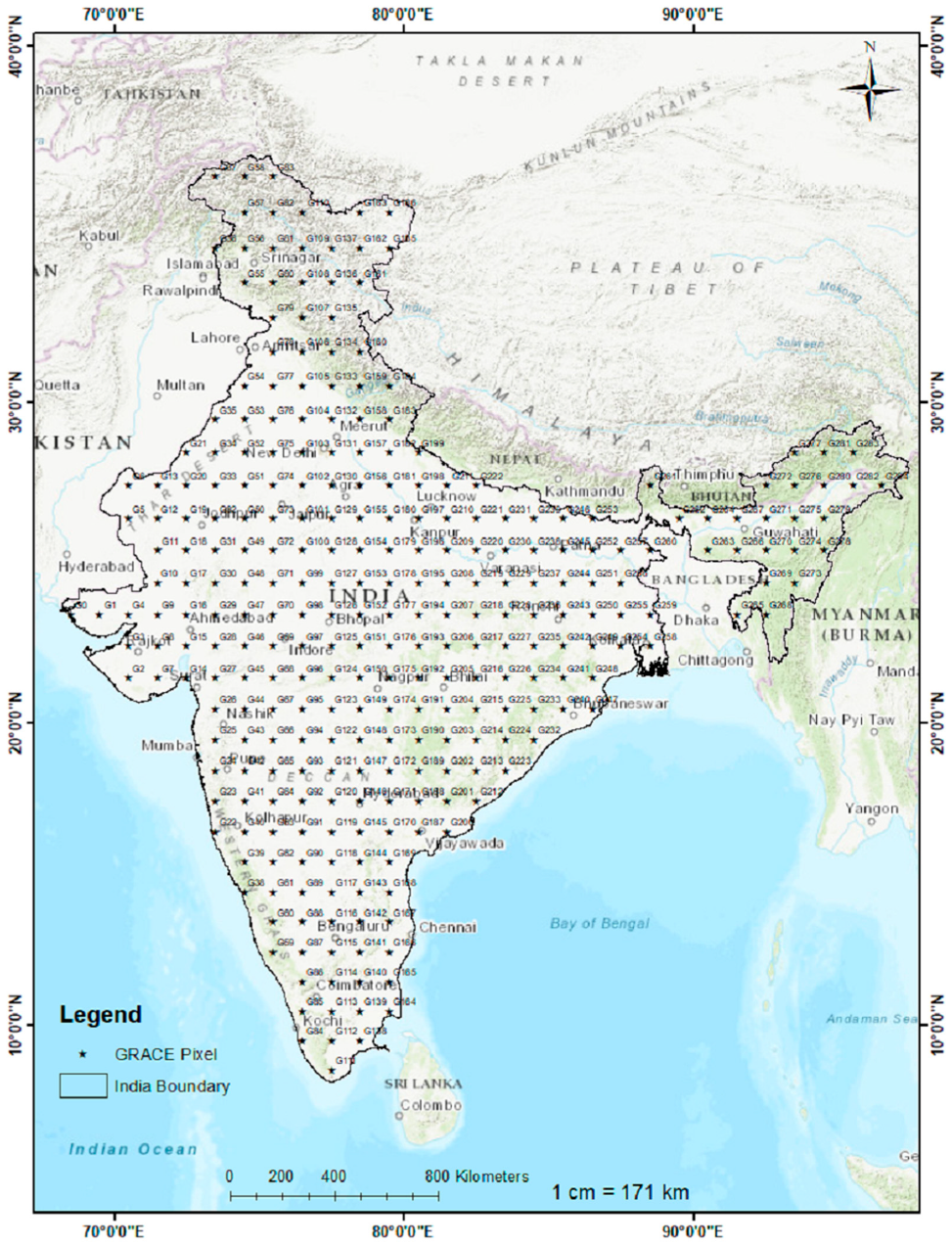
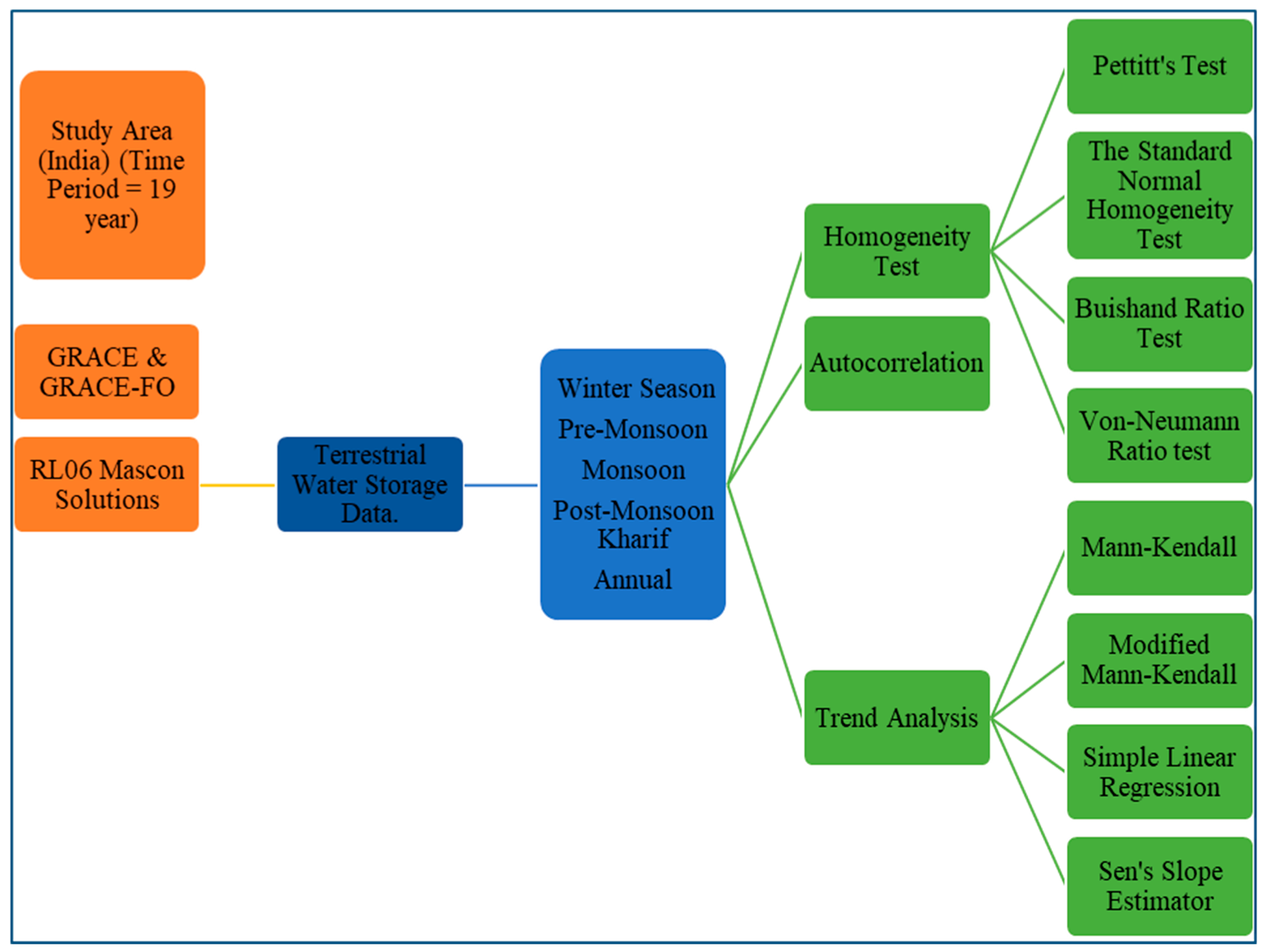
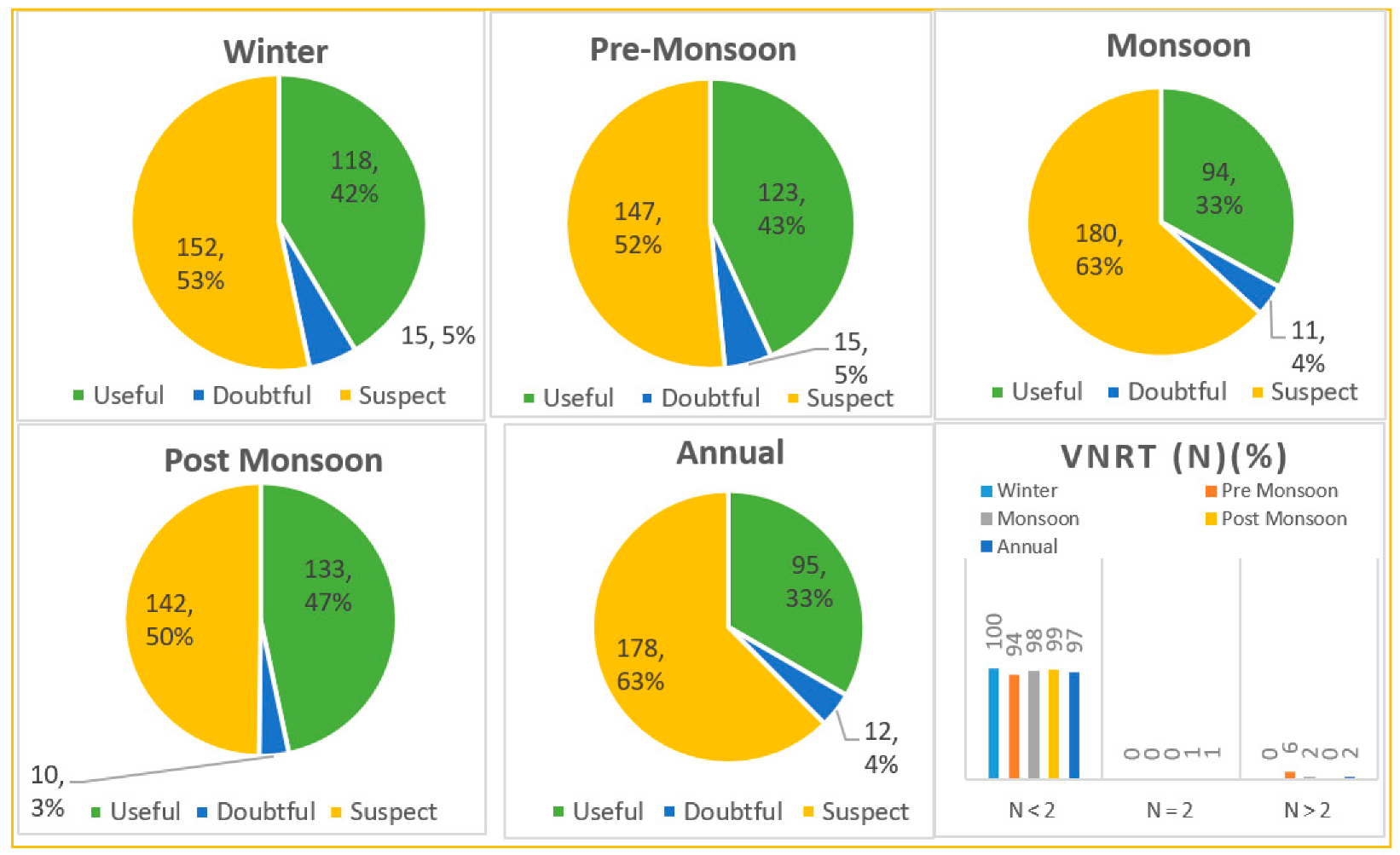
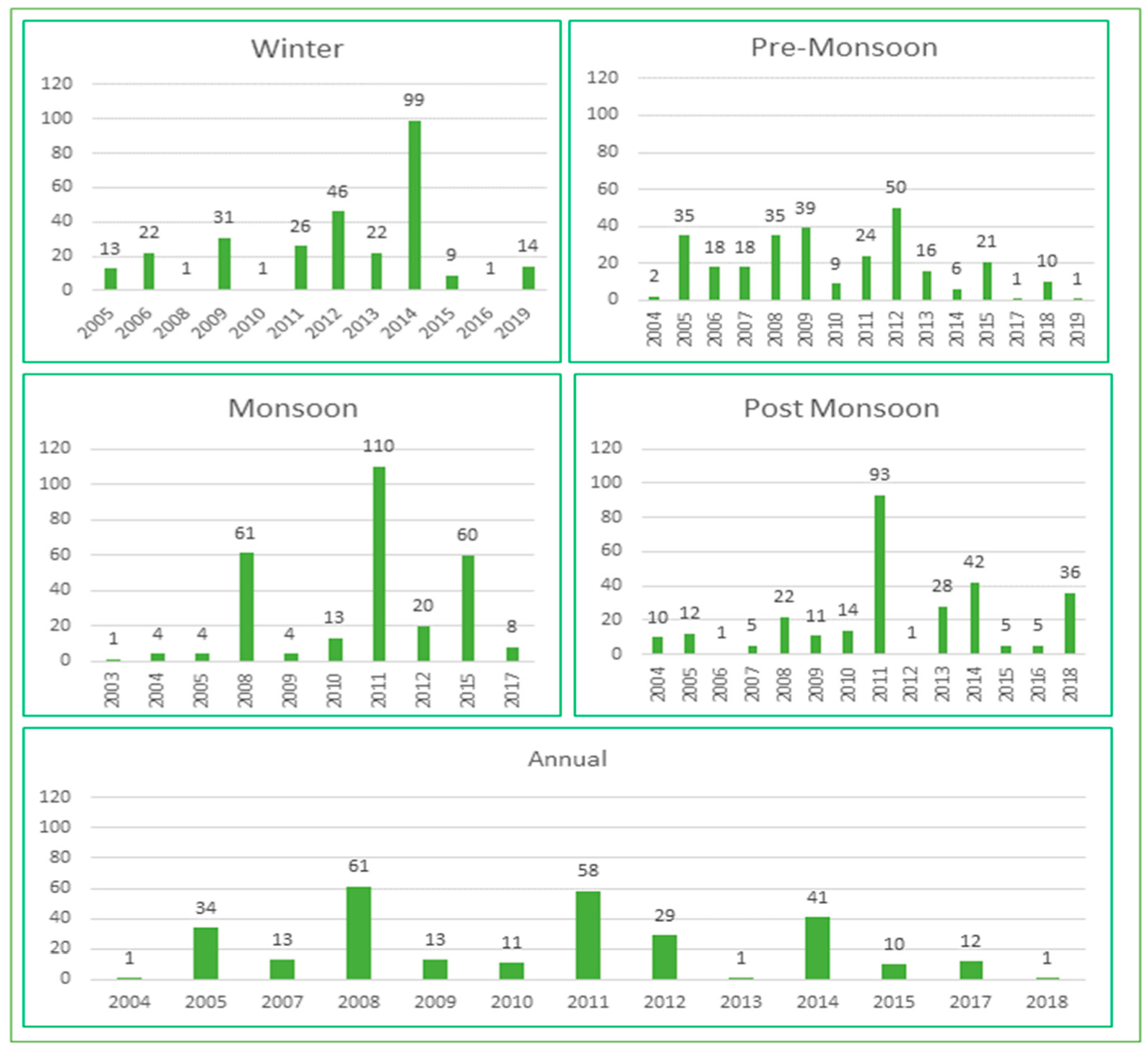

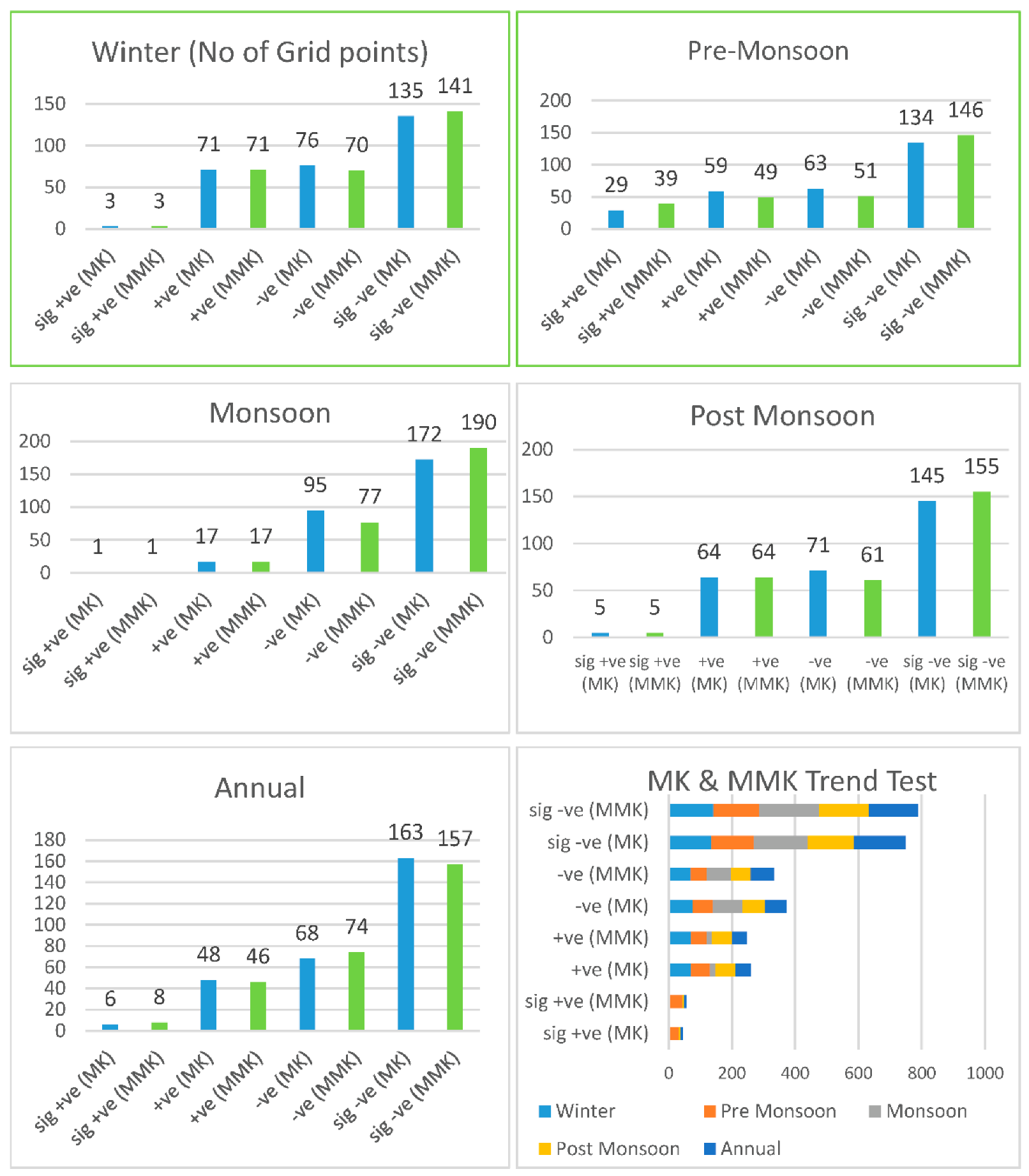
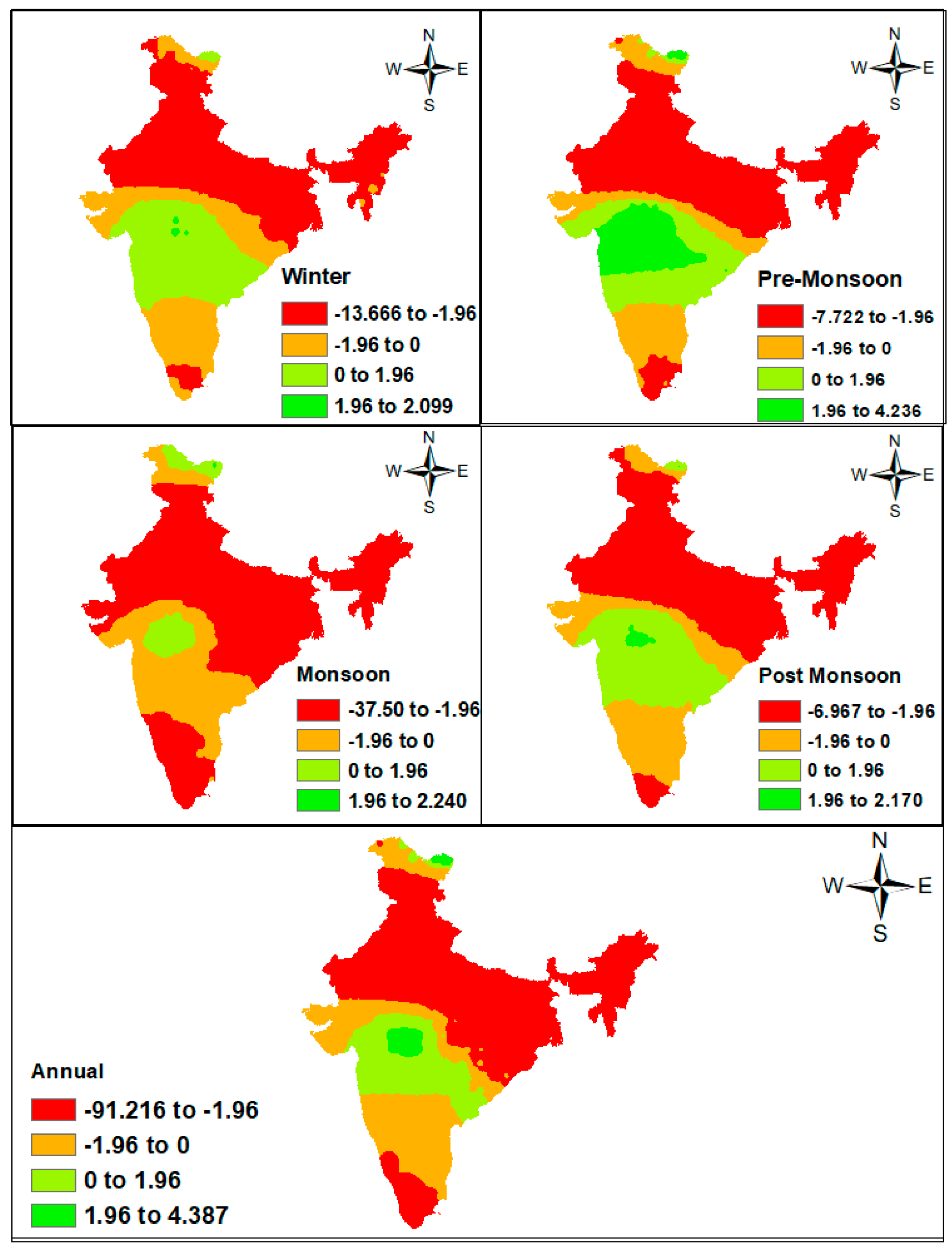
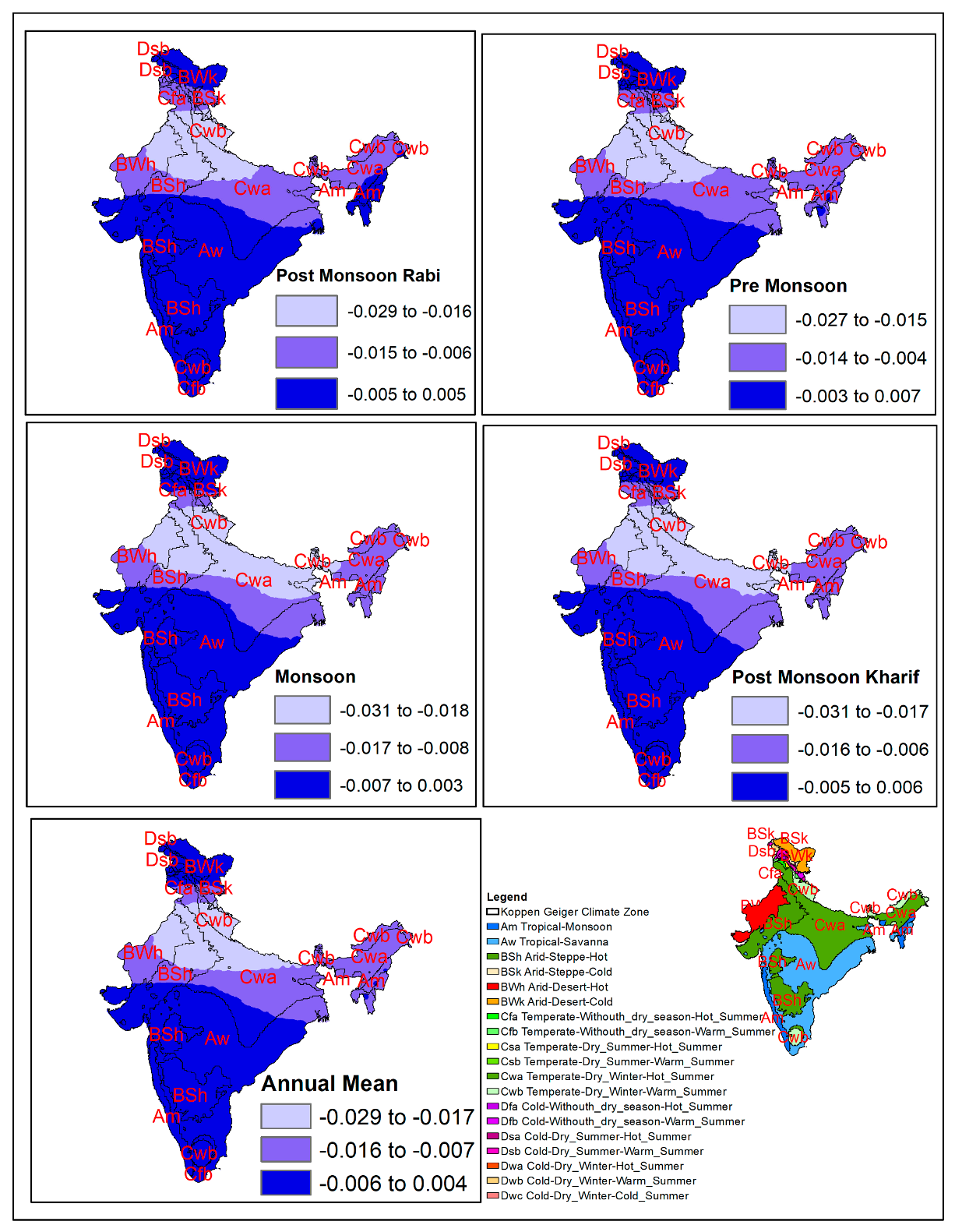
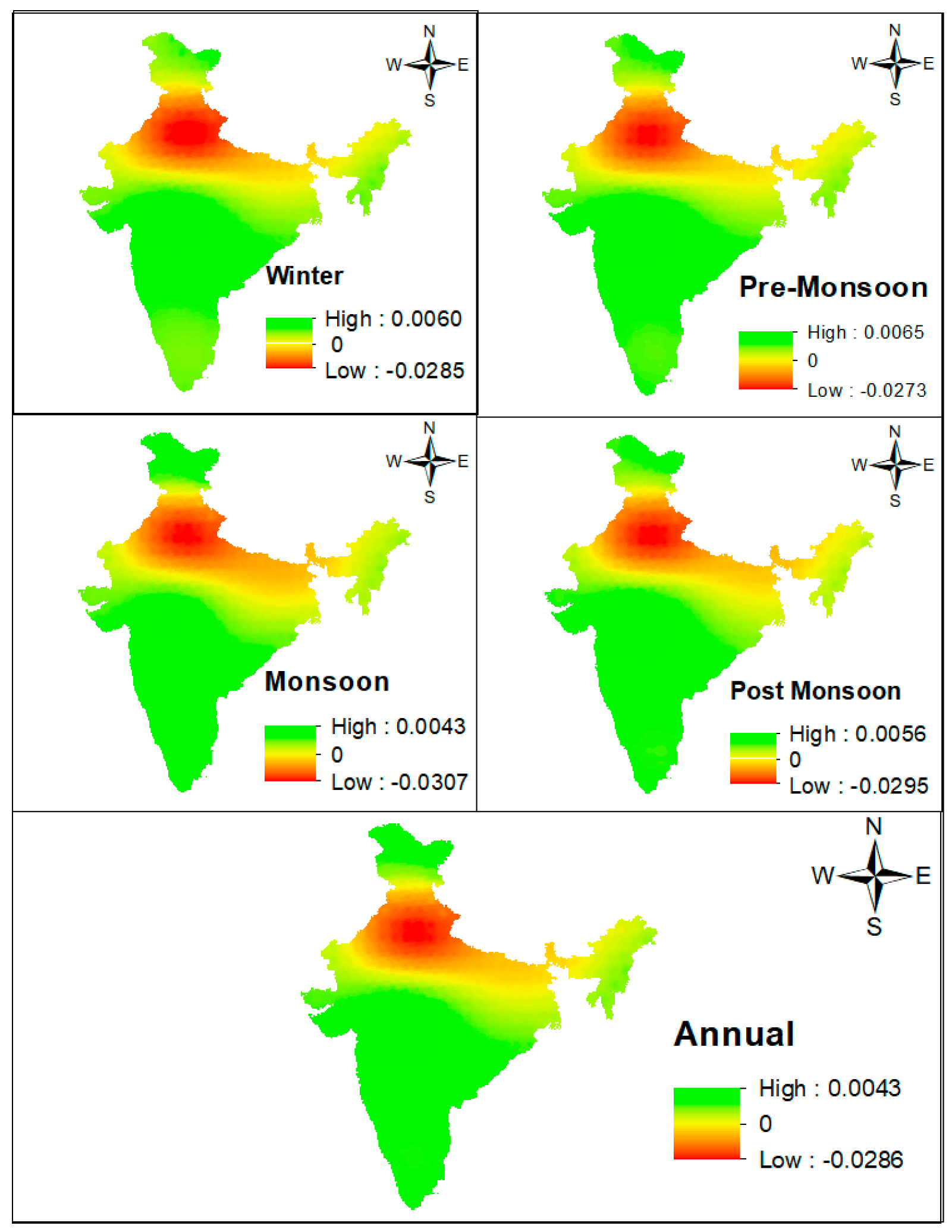


| Climate Zone | Climate Zone | PMR_Min | PMR_Mean | PMR_Max | PM_Min | PM__Mean | PM_Max | M_Min | M_Mean | M_Max | PMK_Min | PMK_Mean | PMK_Max | AM_Min | AM_Mean | AM_Max |
|---|---|---|---|---|---|---|---|---|---|---|---|---|---|---|---|---|
| BSh Arid-Steppe-Hot | BSh | −2.88 | −0.66 | 0.48 | −2.7 | −0.53 | 0.69 | −3.07 | −0.95 | 0.13 | −3.07 | −0.71 | 0.59 | −2.91 | −0.75 | 0.37 |
| Dwb Cold-Dry_Winter-Warm_Summer | Dwb | −2.39 | −0.97 | −0.4 | −2.1 | −0.72 | −0.1 | −2.37 | −0.8 | 0 | −2.49 | −0.97 | −0.3 | −2.29 | −0.79 | −0.1 |
| Aw Tropical-Savanna | Aw | −1.3 | −0.09 | 0.5 | −1.2 | 0.056 | 0.67 | −2.06 | −0.46 | 0.15 | -1.89 | −0.19 | 0.64 | −1.55 | −0.19 | 0.42 |
| Cfb Temperate-Withouth_dry_season-Warm_Summer | Cfb | −2.09 | −1.27 | −0.3 | −1.9 | −1.04 | −0.2 | −2 | −1.06 | −0.2 | −2.13 | −1.22 | −0.3 | −1.95 | −1.07 | −0.2 |
| Csb Temperate-Dry_Summer-Warm_Summer | Csb | −2.09 | −1.27 | −0.4 | −1.9 | −1.1 | −0.3 | −1.99 | −1.16 | −0.2 | −2.12 | −1.25 | −0.3 | −1.95 | −1.14 | −0.3 |
| Cfa Temperate-Withouth_dry_season-Hot_Summer | Cfa | −1.16 | −0.76 | −0.4 | −1 | −0.49 | −0.3 | −0.96 | −0.44 | −0.2 | −1.08 | −0.63 | −0.3 | −0.94 | −0.49 | −0.3 |
| Csa Temperate-Dry_Summer-Hot_Summer | Csa | −0.98 | −0.81 | −0.6 | −0.8 | −0.55 | −0.3 | −0.74 | −0.49 | −0.2 | −0.9 | −0.68 | −0.5 | −0.78 | −0.55 | −0.3 |
| Cwa Temperate-Dry_Winter-Hot_Summer | Cwa | −2.88 | −1.06 | 0.22 | −2.7 | −0.95 | 0.42 | −3.07 | −1.53 | −0.3 | −3.07 | −1.38 | 0.28 | −2.91 | −1.21 | 0.04 |
| Dsb Cold-Dry_Summer-Warm_Summer | Dsb | −2.31 | −0.78 | −0.2 | −2 | −0.53 | 0 | −2.25 | −0.5 | 0.05 | −2.39 | −0.69 | −0.2 | −2.18 | −0.55 | 0 |
| BSk Arid-Steppe-Cold | BSk | −1.38 | −0.68 | −0.2 | −1.3 | −0.46 | 0 | −1.97 | −0.45 | 0.05 | −1.84 | −0.62 | −0.1 | −1.6 | −0.5 | 0 |
| Dfa Cold-Withouth_dry_season-Hot_Summer | Dfa | −0.61 | −0.56 | −0.5 | −0.3 | −0.23 | −0.2 | −0.25 | −0.16 | −0.1 | −0.48 | −0.41 | −0.4 | −0.34 | −0.26 | −0.2 |
| Cwb Temperate-Dry_Winter-Warm_Summer | Cwb | −2.77 | −1.39 | −0.3 | −2.6 | −1.27 | −0.2 | −2.82 | −1.51 | −0.3 | −2.91 | −1.55 | −0.3 | −2.71 | −1.4 | −0.2 |
| Dsa Cold-Dry_Summer-Hot_Summer | Dsa | −0.88 | −0.64 | −0.5 | −0.7 | −0.38 | −0.2 | −0.63 | −0.31 | −0.1 | −0.79 | −0.52 | −0.3 | −0.69 | −0.4 | −0.2 |
| BWh Arid-Desert-Hot | BWh | −2.88 | −1.4 | 0.25 | −2.7 | −1.26 | 0.47 | −3.02 | −1.61 | −0.2 | −3.04 | −1.42 | 0.34 | −2.9 | −1.41 | 0.08 |
| BWk Arid-Desert-Cold | BWk | −1.36 | −0.32 | 0.2 | −1.3 | −0.16 | 0.28 | −1.97 | −0.11 | 0.32 | −1.84 | −0.26 | 0.25 | −1.59 | −0.18 | 0.31 |
| Am Tropical-Monsoon | Am | −1.04 | −0.25 | 0.25 | −1.1 | −0.2 | 0.48 | −1.8 | −0.63 | −0.1 | −1.67 | −0.43 | 0.34 | −1.42 | −0.43 | 0.12 |
| Dfb Cold-Withouth_dry_season-Warm_Summer | Dfb | −1.9 | −1.11 | −0.4 | −1.7 | −0.87 | −0.2 | −1.78 | −0.87 | −0.1 | −1.91 | −1.05 | −0.3 | −1.74 | −0.9 | −0.2 |
| Dwc Cold-Dry_Winter-Cold_Summer | Dwc | −1.39 | −1.37 | −1.3 | −1.3 | −1.29 | −1.3 | −1.97 | −1.96 | −2 | −1.84 | −1.84 | −1.8 | −1.6 | −1.59 | −1.6 |
| Dwa Cold-Dry_Winter-Hot_Summer | Dwa | −0.96 | −0.9 | −0.9 | −0.8 | −0.7 | −0.7 | −0.73 | −0.66 | −0.6 | −0.88 | −0.82 | −0.8 | −0.77 | −0.72 | −0.7 |
Disclaimer/Publisher’s Note: The statements, opinions and data contained in all publications are solely those of the individual author(s) and contributor(s) and not of MDPI and/or the editor(s). MDPI and/or the editor(s) disclaim responsibility for any injury to people or property resulting from any ideas, methods, instructions or products referred to in the content. |
© 2023 by the authors. Licensee MDPI, Basel, Switzerland. This article is an open access article distributed under the terms and conditions of the Creative Commons Attribution (CC BY) license (https://creativecommons.org/licenses/by/4.0/).
Share and Cite
Hasan, M.S.U.; Saif, M.M.; Ahmad, N.; Rai, A.K.; Khan, M.A.; Aldrees, A.; Khan, W.A.; Mohammed, M.K.A.; Yaseen, Z.M. Spatiotemporal Analysis of Future Trends in Terrestrial Water Storage Anomalies at Different Climatic Zones of India Using GRACE/GRACE-FO. Sustainability 2023, 15, 1572. https://doi.org/10.3390/su15021572
Hasan MSU, Saif MM, Ahmad N, Rai AK, Khan MA, Aldrees A, Khan WA, Mohammed MKA, Yaseen ZM. Spatiotemporal Analysis of Future Trends in Terrestrial Water Storage Anomalies at Different Climatic Zones of India Using GRACE/GRACE-FO. Sustainability. 2023; 15(2):1572. https://doi.org/10.3390/su15021572
Chicago/Turabian StyleHasan, Mohd Sayeed Ul, Mufti Mohammad Saif, Nehal Ahmad, Abhishek Kumar Rai, Mohammad Amir Khan, Ali Aldrees, Wahaj Ahmad Khan, Mustafa K. A. Mohammed, and Zaher Mundher Yaseen. 2023. "Spatiotemporal Analysis of Future Trends in Terrestrial Water Storage Anomalies at Different Climatic Zones of India Using GRACE/GRACE-FO" Sustainability 15, no. 2: 1572. https://doi.org/10.3390/su15021572
APA StyleHasan, M. S. U., Saif, M. M., Ahmad, N., Rai, A. K., Khan, M. A., Aldrees, A., Khan, W. A., Mohammed, M. K. A., & Yaseen, Z. M. (2023). Spatiotemporal Analysis of Future Trends in Terrestrial Water Storage Anomalies at Different Climatic Zones of India Using GRACE/GRACE-FO. Sustainability, 15(2), 1572. https://doi.org/10.3390/su15021572









